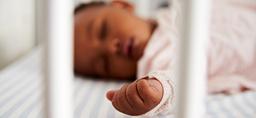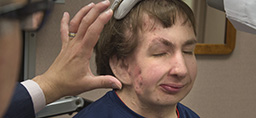
It seems like there’s always some new product on the market appealing to the perpetually exhausted parents of newborns.
Invariably, every new gadget promises to soothe fussy babies and make life easier for moms and dads.
The latest is Babocush, a vibrating soother that has become so popular with parents of newborns that it’s often out of stock on the company’s website.
The device aims to provide an authentic, comforting sensation that a traditional rocker or bouncer can’t necessarily provide.
Here’s how it works: A baby is placed onto the Babocush’s comfy, foam mattress—belly down, slightly upright and face to the side—and secured into a cozy five-point harness. The device then delivers a gentle, soothing vibration and heartbeat sound. It also includes two additional straps to secure the device to a separate baby chair or rocker.
Sounds handy, right? It very well may be.
But buyers should definitely be mindful about heeding the manufacturer’s guidelines, said Jennifer Hoekstra, injury prevention program coordinator at Spectrum Health Helen DeVos Children’s Hospital.
“The reason this product is so popular is that it is absolutely meeting a need that parents are longing for,” Hoekstra said. “But the company has some really specific safety guidelines on their website and in the owner’s manual that parents must follow in order for this to be a safe product.”
1. Do not let your baby sleep on the product.
This is specifically stated in the Frequently Asked Questions section of the product website. If a baby falls asleep on the Babocush, parents should immediately transfer the baby into a crib, according to the manufacturer.
Hoekstra stressed the importance of following this guideline.
“This is not a safe sleeping space for your baby,” Hoekstra said. “Making sure babies sleep alone, on their back, on a firm-surfaced sleeping area is the only safe way babies can sleep. The Babocush is intended to settle down baby and allow them to have some tummy time, but always with the supervision of an attentive parent or caregiver.”
Hoekstra is concerned some parents will be tempted to let their baby sleep on the Babocush, if only to avoid disturbing their sleeping child.
“That is definitely the No. 1 concern,” she said. “‘My baby finally fell asleep! Are you crazy? I’m going to take a nap.’”
But it is imperative that parents transfer the baby to a safe sleeping space.
A baby should never sleep on his belly for two reasons, she said. First, the baby’s face can get pressed against the mattress, covering or blocking the airway. Second, when a baby is on his belly, his esophagus is now on top of the trachea.
The esophagus is essentially the food tube and the trachea is the breathing tube. If a baby spits up while lying on his tummy, gravity can pull the food into the breathing tube.
When a baby sleeps on his back, however, the food tube is on the bottom and the breathing tube is on the top.
“We know that the back-sleeping position is a much better way to sleep,” Hoekstra said.
Edgar Beaumont, MD, a neonatologist at Spectrum Health Helen DeVos Children’s Hospital, also stressed that babies should sleep on their backs at all times, on a firm mattress with nothing else in or on the bed. This means no toys, no pillows, no bumper pads and no blankets.
“For the accidental deaths that occur due to airway obstruction, if those objects are not there, it’s not going to happen,” Dr. Beaumont said. “Everybody baby-proofs their house when their children become toddlers. This is kind of baby-proofing the crib to make it as safe as possible.”
Dr. Beaumont said Safe to Sleep guidelines, which are now 20 years old, have resulted in much lower infant death rates—in some countries, up to 50 percent lower than just two decades ago.
Dr. Beaumont remembers the year the guidelines came out—experts insisted babies would be safer sleeping on their backs.
“I was skeptical,” the doctor said. “It sounded much too simple to be true, and yet it is. The numbers in this country have dropped dramatically.”
2. Secure the Babocush properly.
Secure the device with the straps and don’t place it on floors that are made of wood, tile or any other smooth surface.
The product does not come with its own rocker or chair. Instead, it’s designed to be strapped to another baby chair or rocker that meets the product’s designated guidelines, or it should be used on a carpeted floor.
“One of the biggest temptations will be to put this foam device on something else,” Hoekstra said.
She said it’s not safe for slippery floor surfaces, an adult bed or any raised surfaces.
If you do place it on an approved device, it’s important to use the two safety straps, Hoekstra said.
3. The gadget does not replace the supervision of a caregiver.
Hoekstra urged parents to remember that this device—and any device for newborns or children—does not replace the watchful eye of a responsible adult.
The Babocush website says a baby should never be left unattended on the product.
“Like all baby products, there are moments and times when those products can be helpful tools for parents who are struggling with settling their child or getting them to calm down,” Hoekstra said. “But no product is a replacement for a loving parent or guardian.”
 /a>
/a>
 /a>
/a>
 /a>
/a>